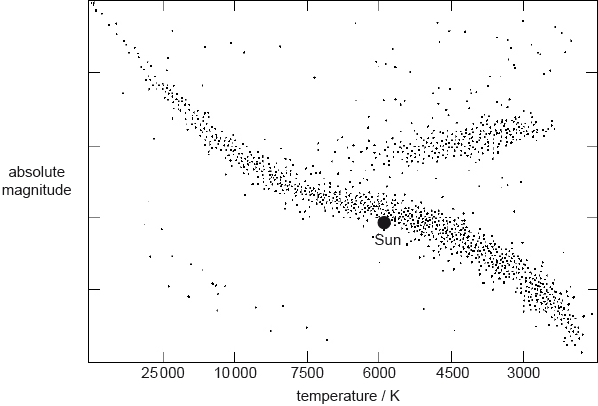| Date | November 2015 | Marks available | 3 | Reference code | 15N.3.SL.TZ0.15 |
| Level | Standard level | Paper | Paper 3 | Time zone | Time zone 0 |
| Command term | Determine | Question number | 15 | Adapted from | N/A |
Question
This question is about the Hertzsprung–Russell (HR) diagram and the Sun.
A Hertzsprung–Russell (HR) diagram is shown.

The following data are given for the Sun and a star Vega.
Luminosity of the Sun \( = 3.85 \times {10^{26}}{\text{ W}}\)
Luminosity of Vega \( = 1.54 \times {10^{28}}{\text{ W}}\)
Surface temperature of the Sun \( = 5800{\text{ K}}\)
Surface temperature of Vega \( = 9600{\text{ K}}\)
Determine, using the data, the radius of Vega in terms of solar radii.
Outline how observers on Earth can determine experimentally the temperature of a distant star.
Markscheme
\(\frac{{{L_{\text{V}}}}}{{{L_{\text{S}}}}} = \left( {\frac{{\sigma {A_{\text{V}}}{{[{T_{\text{V}}}]}^4}}}{{\sigma {A_{\text{S}}}{{[{T_{\text{S}}}]}^4}}} = } \right)\frac{{\sigma {{[{r_{\text{V}}}]}^2}{{[{T_{\text{V}}}]}^4}}}{{\sigma {{[{r_{\text{S}}}]}^2}{{[{T_{\text{S}}}]}^4}}}\);
\(\frac{{1.54 \times {{10}^{28}}}}{{3.85 \times {{10}^{26}}}} = \frac{{{{[{r_{\text{V}}}]}^2}}}{{{{[{r_S}]}^2}}} \times \frac{{{{9600}^4}}}{{{{5800}^4}}}\);
\({r_{\text{V}}} = \left( {\sqrt {\frac{{1.54 \times {{10}^{28}}}}{{3.85 \times {{10}^{26}}}} \times \frac{{{{5800}^4}}}{{{{9600}^4}}}} {r_S} = } \right){\text{ 2.3 }}{r_{\text{S}}}\);
Do not award third marking point if radius of the Sun is lost.
obtain the spectrum of the star;
measure the position of the wavelength corresponding to maximum intensity;
use Wien’s law (to determine temperature); } (allow quotation of Wien’s equation if symbols defined)
Award [3 max] for referring to identification of temperature via different ionizations of different elements.
Examiners report
candidates notably addressed absolute magnitude without referring to apparent magnitude as the question asked. Well-prepared candidates (both HL and SL) only had a problem with the part related to the use of a non-linear temperature scale. Average prepared candidates displayed difficulty in the experimental measurement of the temperature of the distant star and also with details of nuclear processes occurring in the Sun during transformation to a red giant.
candidates notably addressed absolute magnitude without referring to apparent magnitude as the question asked. Well-prepared candidates (both HL and SL) only had a problem with the part related to the use of a non-linear temperature scale. Average prepared candidates displayed difficulty in the experimental measurement of the temperature of the distant star and also with details of nuclear processes occurring in the Sun during transformation to a red giant.

